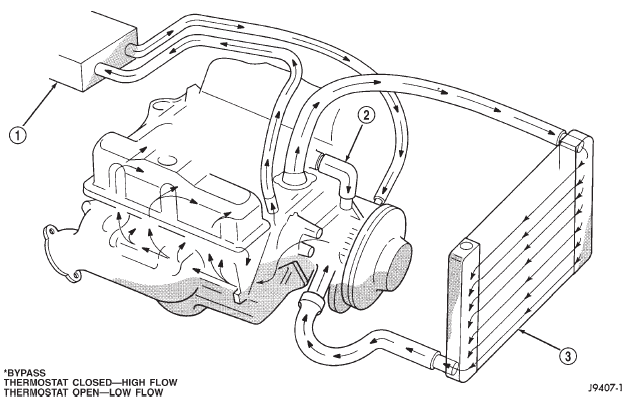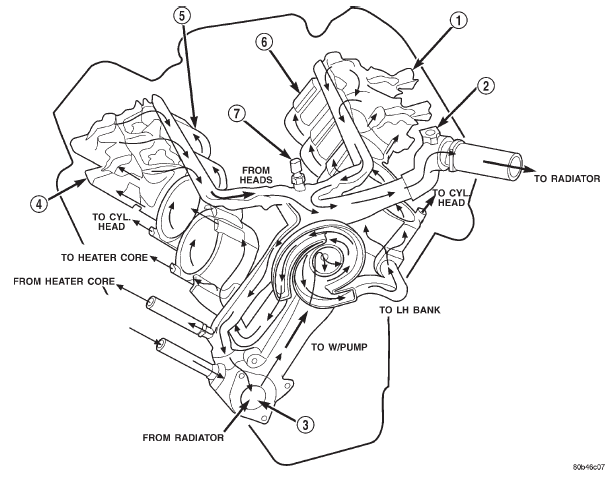Cooling system. Coolant reserve/overflow system
DESCRIPTION The cooling system consists of: OPERATION The cooling system regulates engine operating temperature.
It allows the engine to reach normal operating
temperature as quickly as possible. It also
maintains normal operating temperature and prevents
overheating.
The cooling system also provides a means of heating
the passenger compartment and cooling the automatic
transmission fluid (if equipped). The cooling
system is pressurized and uses a centrifugal water
pump to circulate coolant throughout the system.
An optional factory installed maximum duty cooling
package is available on most models. This package
will provide additional cooling capacity for
vehicles used under extreme conditions such as
trailer towing in high ambient temperatures. Description The coolant reserve/overflow tank is integral to the
upper fan shroud assembly and is made of high temperature
plastic.
1 - Heater 2 - BYPASS* 3 - CROSSFLOW RADIATOR
1 - LH CYL. HEAD 2 - BLEED 3 - THERMOSTAT LOCATION 4 - RH CYL. HEAD 5 - RH BANK CYL. BLOCK 6 - LH BANK CYL. BLOCK 7 - COOLANT TEMP. SENSOR OPERATION The coolant reserve/overflow system works in conjunction
with the radiator pressure cap. It utilizes
thermal expansion and contraction of coolant to keep
coolant free of trapped air. It provides a volume for
expansion and contraction of coolant. It also provides
a convenient and safe method for checking coolant
level and adjusting level at atmospheric pressure.
This is done without removing the radiator pressure
cap. The system also provides some reserve coolant
to the radiator to cover minor leaks and evaporation
or boiling losses.
As the engine cools, a vacuum is formed in the
cooling system of both the radiator and engine. Coolant
will then be drawn from the coolant tank and
returned to a proper level in the radiator.Cooling system
Coolant reserve/overflow system
 Fig. 1 Engine cooling system flow-5.2L/5.9L engines-typical
Fig. 1 Engine cooling system flow-5.2L/5.9L engines-typical Fig. 2 Engine cooling system flow-4.7L engine-typical
Fig. 2 Engine cooling system flow-4.7L engine-typical
Dodge Durango (DN) 1998-2003 Service Manual
- Lubrication and Maintenance
- Suspension
- Differential and Driveline
- Brakes
- Cooling System
- Battery
- Starting Systems
- Charging System
- Ignition System
- Instrument Panel Systems
- Audio Systems
- Horn Systems
- Speed Control System
- Turn Signal and Hazard Warning Systems
- Wiper and Washer Systems
- Lamps
- Passive Restraint Systems
- Electrically Heated Systems
- Power Distribution System
- Power Lock Systems
- Vehicle Theft/Security Systems
- Power Seat System
- Power Window Systems
- Power Mirror Systems
- Chime/Buzzer Warning Systems
- Overhead Console Systems
- Engine
- Exhaust System
- Frame and Bumpers
- Fuel System
- Steering
- Transmission and Transfer Case
- Tires and Wheels
- Body
- Heating and Air Conditioning
- Emission Control Systems
- Introduction
